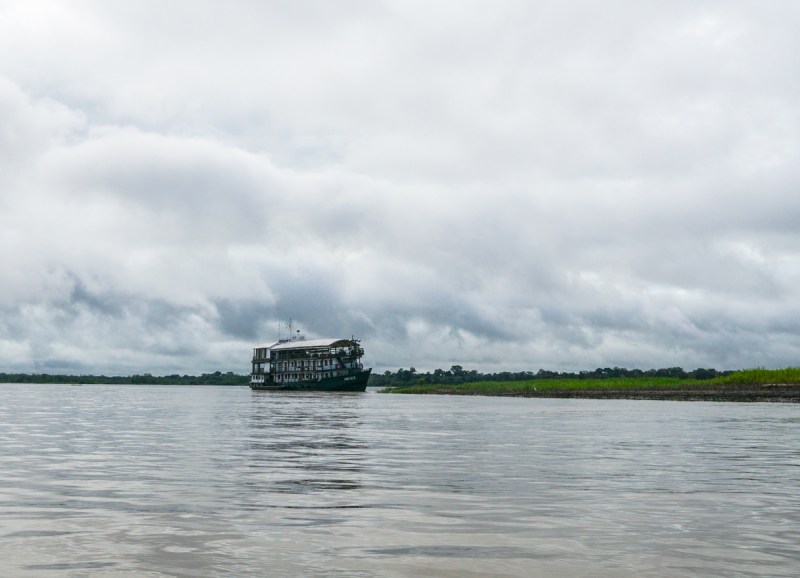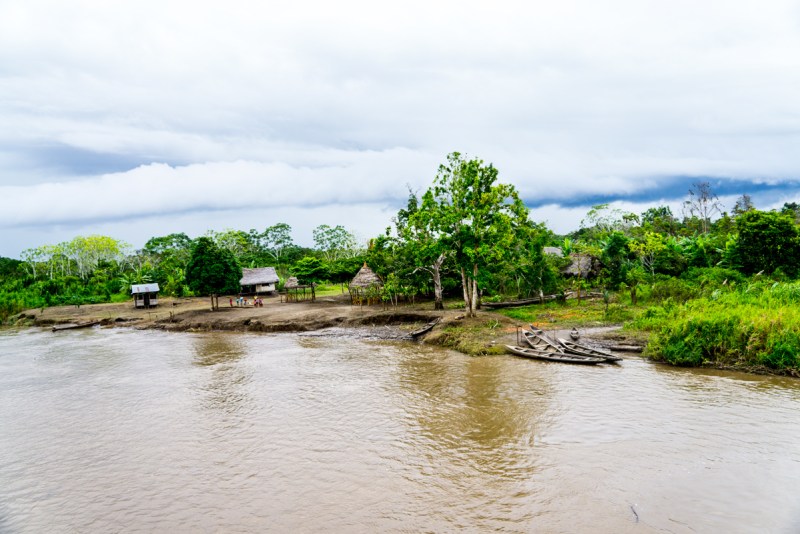Rainbow in the Amazon © D. M. DeKraker
Amazon Rainforest of Peru

Peru’s Amazon Basin, on the eastern side of the Andes mountains, comprises about 60% of Peru. It borders Brazil, Bolivia and Colombia in South America. It is covered in rainforest and rivers. It is sparsely inhabited, and filled with wildlife. However, it is hard to see the wildlife because of the forest .Iquitos, the largest city in this area, can only be reached by air. With 400,000 people, it is the largest city in the world only accessible by air. There is a 60 mile stretch of road along high ground, but no access from the rest of Peru. From Iquitos you can take a boat up or down the Amazon River. Iquitos is actually an Atlantic port, although it is 2,300 miles from the Atlantic. So the country of Peru on the Pacific Coast of South America has access to both the Pacific and Atlantic Oceans.
Iquitos

In Iquitos, motorcycles are the most commonly used vehicles. They also have buses that are made of wood shown above. There are many of the cyclo-rickshaws for easy transportation around the city. Since Iquitos is the starting and ending point of many Amazon tours, there are nice hotels, good restaurants and tourist facilities. We visited a butterfly farm and an animal rescue center while in Iquitos.
Trip Information
On this trip, I traveled with Overseas Adventure Travel. I took a pre-trip to the northwest coast of Peru first to see Peruvian pyramids. We stayed a couple of days in Lima before flying to Iquitos. We visited sites around the Iquitos for two days before boarding the boat to cruise the river.
This trip was in early May, and the annual floods had receded enough for some indigCheck out teenous farmers to plant their crops, but some forest was still submerged.
Adventure in Peru’s Amazon Basin
We canoed through the flooded forest with locals. Each of us got in to a separate canoe with a local to guide us through the flooded forest. This was both beautiful, with reflections, and a lot of fun. We were near the limbs of the flooded trees. Another day, we got to hike in the highland forest to see boa constrictor, anaconda and poison dart frogs.
We swam in the Amazon River with the pink river dolphins. Actually, I saw the dolphins before I got in the water, but not afterward. These are totally wild. Pink freshwater dolphins have capillaries near the surface of their skin, so sometimes they are pink and sometimes grey. They were plentiful in the area we visited. We also fished for and caught piranhas with a fishing pole. Unlike the Hollywood portrayal, locals eat a lot of piranhas instead of the other way around. Piranhas have sharp teeth, will eat anything, but we saw them mostly in reedy areas near the shore.
Amazon River Cruise

We cruised along the river. What amazed me the most is the amount of water. Even smaller tributaries seemed to be as wide as the Mississippi River. We took a skiff to go up smaller streams to see wildlife and other things several times a day. The cruise boat is made of mahogany. Every evening we ran aground and tied to trees to stop overnight. There are no ports or docks in the jungle.
Pacaya Samiria National Reserve
This is an enormous reserve, 7,700 square miles. It is the largest in Peru, but gets only a few hundred visitors each year. Large amounts of wildlife live here, around 100 varieties of mammals and over 500 species of birds. The area is protected, but native tribes already living in the reserve before it was made a reserve are allowed to continue to live here. We visited the reserve a number of times during the day and also at night.
Wildlife in Pacaya Samiria
Wildlife along the river is difficult to see, even if you are on a skiff in narrow channels. In the above photo on the left, only egrets along the river edge are visible. We did see some wildlife, but it is hard to get good photographs of the wildlife. I did get a few animal photos including the hoatzin and emerald skink above. Hoatzins are only found in the Amazon Rainforest. They are primitive birds and are ruminants, like cows. No other bird is a ruminant. These birds were found along the Samaria River. It took a long lens and cropping afterwards to get this photo from the skiff.

Natives along the Amazon
We visited a shaman one afternoon. Another time, we visited a small village. We ate lunch with a family in their home in the village. This is one of the things I really like about Overseas Adventure Travel. We always get to visit locals and usually visit a school. We watched as this woman took a few minutes to create this backpack from a palm frond.

References
Adventure Travel Handbook
Wikipedia
Amazon Basin Introduction and Travel Guide




